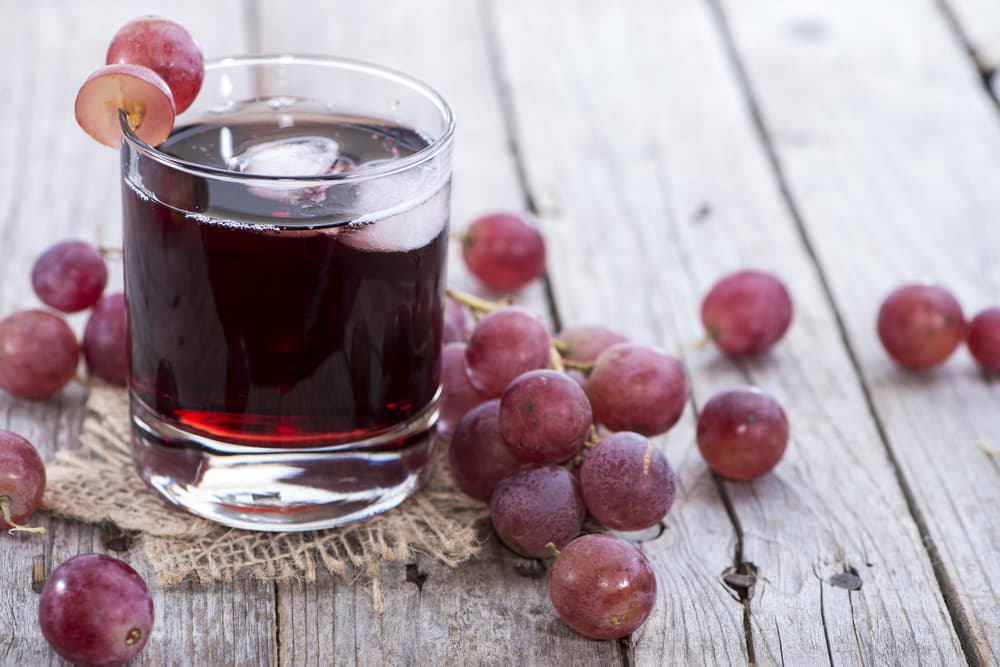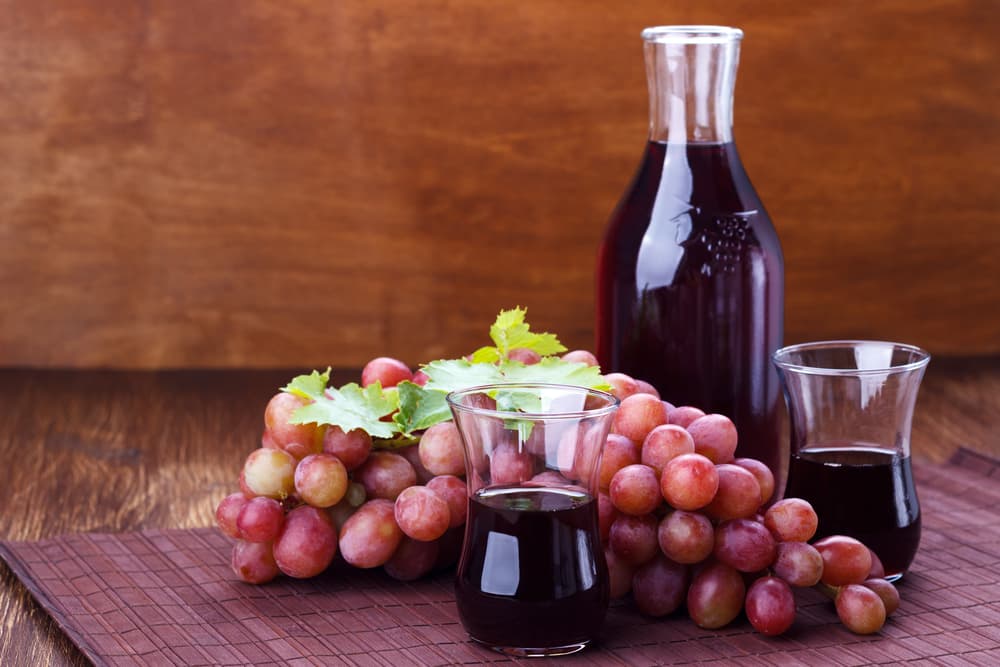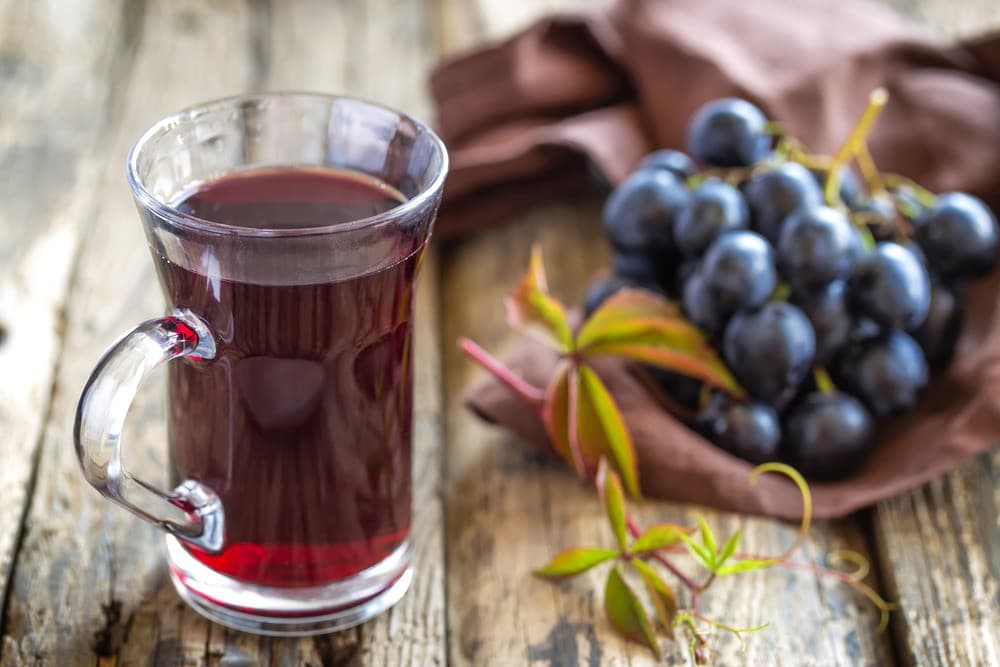Do you know producing black grapes juice has some benefits and maybe some side effects? It has a distinctive color and sweetness along with many important antioxidants and nutrients. Reports confirm the beginning of its cultivation at least 6-8000 years ago. They also state that black grapes are the oldest fruit cultivated in Europe and the Near East. Black grapes are known botanically as Vitis vinifera. Consuming black grapes in juice form will also ensure many benefits for the individuals. This is a brief guide on the benefits of black grape juice. Top Benefits Of Black Grape Juice Black grape juice has many uses as you already know. Here are some of the most important health benefits of black grape juice that you should be aware of:
- Rich in antioxidant content
The main benefit of drinking black grape juice is to supply the body with a good amount of essential antioxidants such as resveratrol. The antioxidants in black grape juice help fight free radicals in the body.
- Protects the heart
Studies show that black grapes may offer protection from a condition known as metabolic syndrome-related organ damage. It's a group of problems combined, such as high blood pressure, diabetes, increased body fat, and low levels of good cholesterol, or HDL. Grapes contain a compound called resveratrol that helps facilitate blood flow and increase circulation. Phytochemicals also help reduce the risk of heart damage while also significantly regulating cholesterol.
- Increases eyesight
Black grapes contain carotenoids such as zeaxanthin and lutein that contribute significantly to improving eyesight. They help fight retinal damage and blindness.
- Fights the risk of cancer
Black grapes contain many antioxidant properties that help fight many types of cancer such as breast cancer. Therefore, drinking black grape juice is as effective as eating black grapes in preventing the risk of cancer.
- Increases brain function
Black grapes nutrition protect the brain and dramatically increase memory levels as well as enhance focus. Besides protecting brain health, they contain riboflavin which benefits people with problems like migraines. Resveratrol is found in grapes and will help reduce beta-amyloid peptide levels in people with Alzheimer's disease.
- Fights the risk of diabetes
Drinking black grape juice helps fight the risks of diabetes. They enhance insulin regulation while increasing sensitivity to the same. It contains pterostilbene which helps in lowering blood sugar levels. Black grapes have a low glycemic index value between 43-53 which helps a lot in balancing blood sugar levels.
- Increases hair health
There are many benefits of consuming black grape juice for healthy hair. It contains vitamin E and antioxidants that help improve blood circulation levels in the scalp, thus combating split ends, hair loss, and premature graying of hair.
- Increases the level of immunity
Drinking black grape juice daily can also help boost the overall immunity of the system as it contains vitamins A, C, and K. It also contains minerals and flavonoids along with organic acids and sugars.
- Increases skin health
There are many benefits of black grape juice for skin that you should be aware of. It also contains antioxidants such as proanthocyanidin and resveratrol. This ensures greater protection from harmful UV rays and significantly reduces wrinkles and dark spots. Black grapes also improve skin elasticity by significantly increasing blood circulation levels.
producing grape juice
Producing grape juice process includes raw material selection, cleaning, stem removal, crushing, color distillation, extraction, filtration, mixing, filtering, filling and sealing, sterilization and cooling.
- Selection of raw materials
Choose fresh, perfectly cut grapes with a rich, juicy flavor. Remove immature, overripe, diseased, or infected grapes. The fruit sorting machine can save you labor in the process.
- washing grapes
Dip the selected grapes in a 0.03% solution of potassium permanganate, then rinse them in running water until the red color disappears. To efficiently clean grapes, you can use a fruit washing machine. It is special equipment for cleaning fruit. The water falls below the water pump function and rotates the fruit into the water tank. When they are taken out of the tank by the elevator, some sprays scratch their surface. After these operations, impurities and dirt are completely removed.
- Crush and remove stems and seeds
Grape stems make up 3-8% of the weight of the fruit. Its main component is lignin, which contains 1-2.5% tannin, 0.5-1.5% acid, and a little bit of bitterness. If it contaminates the fruit juice, we must remove it before grinding it. A grape stalk is a special tool for this process. It can remove grape stems, crush grapes and convey grape pulp with a single screw pump. The graduated speed screw feeder can achieve quantitative feeding. The grape stem accommodates different types of grapes by adjusting the rotation speed. The crushing roller is made of high non-toxic electric rubber, with no harm to grapes. The crushed grape pulp is conveyed to the next stage by a screw pump. The pore size of the cylinder can be adjusted according to the size of the grape seed, so the maximum and minimum grape size must be provided upon request.
- Heating for color distillation
Heat crushed grapes to 60-70 degrees. Continue this process for 15 minutes so that the colors of the grapes penetrate the juice of the fruit.
- Grape juice extraction and filtering
Extract the juice from the crushed pulp of grapes, then strain the juice and remove the slag with a cloth bag.
- Grape juice mixture
Pour grape juice into a storage container for mixing. Add 20% liquid sugar to the juice and set the sugar level to 16%. Then 3 kg of 2% metatartaric acid is added per 100 kg of grape juice if the tartar separates from it.
- Purification of grape juice
Clarify turbid grape juice with gelatin and tannins. Add 4-6 grams of tannin per 100 kg of grape juice. After 8 hours add 6-10 grams of gelatin to it. The appropriate temperature for clarification is 8-12 ℃. When all the flocs in the juice have sunk to the bottom, you can sip the clear liquor with basins. After that, you can heat the filtered juice to 80-85 ° C.
- Filling and sterilization
Pour the grape juice into a sterilized bottle and close it once. Then put these bottled juices in 85 hot water for 15 minutes. After that, slowly add cold water to reduce the temperature to 35°C. Then you can dry the bottles and label them with your brand.
black grape juice benefits
Black grape and its juice have many benefits for us. Black grapes have been cultivated in Europe and Asia for more than 6000 years. The black grapes we enjoy today (Vitis vinifera) come in two varieties - one that grows in western Asia near the Black Sea, and one that grows in the Americas. Most are grown for use in wine, but they also make a tasty and healthy snack. The average American eats five pounds of grapes each year, making it the fourth most popular fruit in the country. The nutrients found in black grapes include polyphenols, which are powerful antioxidants, as well as a variety of essential vitamins and minerals.
- Health benefits
The health benefits of black grapes have been extensively studied. The chemicals in it can give you healthy hair and skin, improve your heart health, and protect your cells from cancer.
- Improve cardiovascular health
One of the most famous benefits of resveratrol is to improve heart health. You may have read that drinking red wine helps stabilize blood pressure, lower cholesterol, and reduce the risk of heart disease. Scientists believe that resveratrol, found in the skins of red and black grapes, gives red wine its heart-healthy properties. Some types of black grapes have a much higher percentage of antioxidants than green or red grapes. These chemical compounds help protect your cells from damage. They protect against diseases such as cancer, diabetes, Alzheimer's disease, Parkinson's disease, and heart disease. They can also help you recover from illness faster.
Resveratrol, an antioxidant found in grapes, is believed to provide exceptional protection for the heart and brain. It is also known to help the body fight cancer, viruses, and infections.
- Improve cardiovascular health
One of the most famous benefits of resveratrol is to improve heart health. You may have read that drinking red wine helps stabilize blood pressure, lower cholesterol, and reduce the risk of heart disease. Scientists believe that resveratrol, found in the skins of red and black grapes, gives red wine its heart-healthy properties.
- feed
Black grapes contain 82 percent water, which makes them low in calories despite being high in natural sugars. All this water rejuvenates and moisturizes the body. In other words, grapes are sweet but still low in calories and fat-free.
- Things to watch out for
Compounds in grapes can slow blood clotting. Although grapes have not been shown to cause problems for humans, you may want to limit your intake of grapes if you have a bleeding condition or are preparing for surgery. Also, note that grapes are a choking hazard for young children.
- How to prepare black grapes
The rich, subtle flavor of black grapes goes well with a variety of foods. They bring sweetness to salads, balance out oily foods, and make a comforting snack. Add half a grapefruit and sliced almonds to a chicken or tuna salad Use black grapes to add color and sweetness to your cheese plate Snack on grapes and nuts for a healthy afternoon meal Add grapes to a fruit salad Put black grapes in a green salad with strawberries, pineapple, walnuts, and blue cheese Serve black grapes in small bunches with quiche. 
producing black grape
The seedless black seedless grapes are small to medium in size and slightly round to elliptical. Their skin turns a deep purple to almost black, and some varieties may have waxy flowers or a waxy membrane on the surface to prevent moisture loss. The skin is firm and does not slip off the body. The flesh is translucent, tender, and less tender than most red or green table grapes. Although seedless black grapes are defined as seedless, they sometimes contain one to two small, nearly unrecognizable, edible, fleshless, and immature seeds. Juicy, seedless black grapes with a sweet grape-musky flavor.
- Current facts
Within the genus Vitus, there are several species of black seedless grapes, including vinifera, labrasca, Riparia, rupestris, and rotundifolia. The most common seedless black grapes grown as table grapes are Vitis vinifera and Vitis labrusca, or a combination of the two. The seedless black grape is prized because of the rich, juicy pulp, a very sweet flavor, and highly aromatic skins that provide a pleasant chew. Some of the other popular varieties on the market are Black Monika, Summer Royal, Autumn Royal, and Black Emerald.
- Nutritional value
Seedless black grapes contain large amounts of vitamins A, C, and K. The flavonoids in grape skins, such as resveratrol, provide antioxidant properties that may help reduce the risk of cardiovascular disease.
- Applications
Seedless black grapes are best suited for raw applications and are often eaten fresh, out of hand, or tossed into a green salad. It can be pressed to make juice and dried to make raisins. The seedless black grapes can be roasted, cooked in sauces and jams, baked into pies, or frozen and whipped into instant syrup. The rich flavor and sugar content inherent in black grape juice is also a natural sweetener for fresh fruit cocktails. Seedless black grapes blend well with thyme, mint, rosemary, honey, balsamic vinegar, rich cream, blue cheese, lemon juice, orange juice, asparagus, almonds, and pistachios. They will last up to a week when stored in a perforated plastic bag in the refrigerator.
- Ethnic/Cultural Information
The California grape industry has shifted its focus to seedless grapes to meet consumer demand. In 1923, the United States Department of Agriculture (USDA) established a breeding program in Fresno, California in an effort to develop seedless grapes that would be sweet but edible. The production of seedless black grape varieties has increased dramatically, and the grape has become popular for its antioxidant and resveratrol content. 
- geography / history
The first seedless grape was a naturally occurring European grape with origins between the Black Sea and the Caucasus and a genetic anomaly that stopped seed growth. This unique variety is the ancestor of all seedless grapes. Modern black grape cultivars are the result of "embryo saving," a complex process in which young, developing seeds are removed from promising grapes. The seeds are then cultured in small rooted plants in Petri dishes and test tubes. This is done to create new viable species because, in nature, they have very little chance of surviving. Black seedless grapes can be found in markets and stores in the United States, Europe, South America, and Asia.





0
0